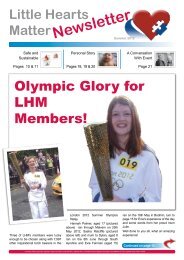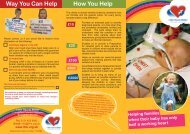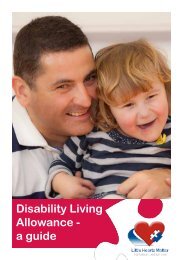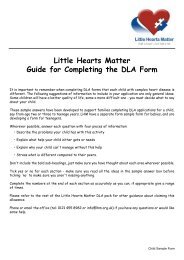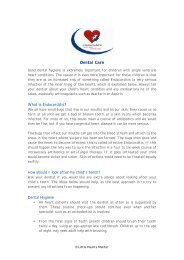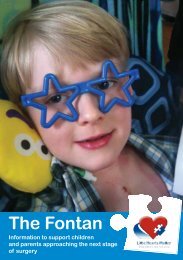Zipper ZoneBelow Jon gives an update on the youth research that has beenundertaken over the last two years.Written byJon BrunskillYouth Development Officer20We know that the physical, psychological and emotionaldevelopment that an adolescent goes through duringteenage years can create huge challenges. Add into thisturmoil a complex heart condition and the anxiety andconfusion is only compounded. <strong>Little</strong> <strong>Hearts</strong> <strong>Matter</strong> hasworked closely with families affected by single ventricleheart defects (SVHDs) for over twenty years, but to datet<strong>here</strong> is very little primary data that has been collected fromthe young people in which they are able to voice the physicaland psychological effects of these non-correctable heartconditions.Anecdotal evidence from parents and teenagers wouldsuggest that t<strong>here</strong> is a clear link between living with a SVHDand struggling with challenges above and beyond those ofa normal adolescent. Often the support needed to ensurethat these young people can reach their full potential isinconsistent or simply not existent. The aim of the ‘How IFeel’ Study was to provide quantified data supported byqualitative experience that would support the need forchange within medical care, education services, careersupport and social services. We also hoped to identifychallenges that may be incidental or occasional.Over the last two years the LHM Research Team -consisting of Suzie Hutchinson, two parent trustees, twoclinical psychologists, a youth worker and myself - haveworked to create an accessible questionnaire targetingissues which have been identified as obstacles to youngpeople developing towards an independent life. Thequestionnaire was broken down into the following sections:• Hospital and Medication• Family and Friends• School• Feelings and…stuff• Big Kids (for young people in Year 9 or over)• Diet and Food• Sports and Activities31 young people, aged between 10 and 18, took part inthis questionnaire. Young people treated at Southampton,Birmingham, GOSH (London), Evelina (London), Alder Hey(Liverpool), Glenfield (Leicester) and Freeman (Newcastle)were represented.The participantshad a range ofSVHDs, includingHypoplastic LeftHeart Syndrome, Pulmonary Atresia, Tricuspid Atresia andUniventricular Heart. Analysis of their response is currentlyunderway, however initial results would suggest that thedata supports anecdotal evidence.For example, of the 31 participants, 26 attended amainstream school, and of these 26 only 10 receivedlearning support.• 26/31 attend mainstream state schools• 16 receive no support• 10 receive supportThis data will be supported by qualitative data collectedthrough telephone interviews with young people with aSVHD. The aim is to illustrate the figures with powerfulexplanations from the young people directly affected bythese conditions.All young people aged 10 – 18 will be offered theopportunity to take part in this interview, and we hope toreceive your support in our endeavour to produce a rigorousaccount of how it actually feels to live with a heart conditionas an adolescent. The outcomes of this project will be moreaccurately targeted service provision from <strong>Little</strong> <strong>Hearts</strong><strong>Matter</strong>, as well as an invaluable tool for the entire spectrumof care givers to these young people.
The reviewEvery issue we feature a review of a book, website or filmthat our members may find interesting.In this issue, Lindsey Hooks reviews 'Before My HeartStops' written by Paul CardallWritten byLindsey HooksCan be purchased from Amazon fromaround £9.98 - www.amazon.co.ukwww.paulcardall.com"I was born with half a heart.God made up the difference'Paul Cardall was born in 1973 withTricuspid Atresia, a single ventricleheart condition and was only givendays to live. He defied medicalexpectations and endured a series ofsurgeries and childhood illnesses.While in High School tragedy struckand his best friend was killed in a caraccident. After having quit playing thepiano a decade earlier Paul tookcomfort in music and composed amuscial tribute. He is now an awardwinning pianist and number 1 Billboardchart artist from Salt Lake City, Utah."The best way I know how toexpress the raw deep emotionsI've experienced is through thepiano music I create."Paul is a dedicated Mormon fromSalt Lake City, Utah w<strong>here</strong> he liveswith his wife and daughter, Eden. Thisbook is essentially a diary of his day today life from when he was put on thetransplant list up to the point, 385 dayslater, when he received his new heart.Whilst waiting for his new heart Paulwas in end-stage heart failure, he wason oxygen 24/7, took a daily cocktail ofdrugs, spent several nights in hospitaland long periods w<strong>here</strong> he wascompletely exhausted. If you haveread his blog 'Living for Eden' (namedafter his daughter) you will already befamiliar with the majority of thematerial, however, I only becameaware of him on Facebook when hisbook was being released.T<strong>here</strong> is no doubt that Paul's story isone close to all our hearts, his positivityand attitude is very uplifting and is aninspiration to everyone, not just thosetouched by heart disease. Theexample he sets on how to approacheach challenge is a lesson to us alland is humbling especially when youthink of trivial issues which take ourtime and energy day to day.It is very apparent that Paul is adeeply religious man and hisresounding faith influences him andimpacts everything he experiences. Ifyou are religious I'm sure you will beable to relate to what he says, however,it is a very big part of the book and theconstant references can be a littledistracting. That said, t<strong>here</strong> is nodoubting his sincerity and it is apparentthat his faith has helped him, and thoseclose to him, cope with the difficultiesthey have had to go through.Overall I enjoyed the book. It isalways a pleasure to read aboutpositive people with heart conditionslike our children. I came away feelingthat whatever is around the cornert<strong>here</strong> is no harm in looking at the 'glasshalf full' and what can be done, ratherthan all the challenges and struggleswe inevitably face. Personally I wouldhave liked less of a focus on t<strong>here</strong>ligious aspect however, you have toappreciate that this is who Paul is andit doesn't detract from what a positiveand uplifting role model he and hisfamily are.I will finish with an extract I foundwhile researching about Paul Cardellbefore I bought the book. Dr AngelaYetman and Dr Melanie Everitt arePaul's paediatric cardiologists. For methis sums up both Paul and his family'sapproach to life entirely and sends apositive message to all us heartparents."It's the most severe heart diseasewe see," explains Dr AngelaYetman. "He is alive and he's alsodone so well for himself." She saidCardall's "personality andtemperament with an optimisticoutlook have helped him survive,as have his parents, whosewillingness to let him experiencelife rather than sheltering him forfear of the health consequences.""They've made plans for thefuture," Everitt said. "Some kidsand parents see this (disease) as adeath sentence... We want to givethem hope." Medicine andtechnology have advanced to thepoint, that such patients can lookforward "not just an extension oflife, but a full and active life." shesaid.21




